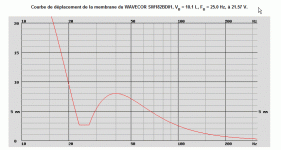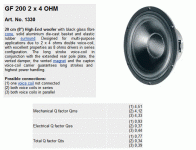1. I would rather go with the SEAS. I don't know, I just looked (it) for you.1. Inductor, thanks for all the help. I really appreciate your advice. How come you know so much about Wavecor drivers. Have you used any of them? I happened to chance upon them at an affordbale price (about the same price as SEAS Prestige).
2. I just like the look of the Focal Chorus/Electra series so wanted to make speakers (floor standing, rear, center and bookshelf) that looked similar.
2. Yes. In fact they are superior in the >5,000 ($/€) mark.
3. Yes you are right. I should first narrow down my main driver (which I define as 200-3000Hz). WF120 is smaller and has nicer respnse than the 182 above 2k (till about 5/6k). Does it make sense then to use the SW182 for the bass and the WF120 for the mid (say crossing over at 200-300Hz)? Would I run into SPL limitations with the WF120 (if used above 200Hz)? Should I then consider the WF152 instead?
The WF152 is OK with me.😎
WF152BD03_04
The WF120BD03_04 also looks nice (I don't know probably for the center speaker w. much less SPL, 86 vs 88.5).
Note that Le is marked on the specs as measured at 10K (much less) for their speakers, what is not very usual. The most used parameter is the one measured at frequencies of 1KHz, where you have xovers, simulations and all.
Note that Le is marked on the specs as measured at 10K (much less) for their speakers, what is not very usual. The most used parameter is the one measured at frequencies of 1KHz, where you have xovers, simulations and all.
Back to the original question: adding two equally loud noise sources (incoincident sound sources) adds 3 dB; adding two coincident sound sources (same signal in phase) adds 6 dB. Hence in a xover when the two drivers are in phase 6dB down at the xover-frequency, they will add to 0dB. That is what a LR filter setup does.
Two woofers will also almost add up to 6dB, since the lowest bass is usually mixed to both speakers, so both are fed with a coincident signal. Add room gain to it, and it might be even more.
vac
Two woofers will also almost add up to 6dB, since the lowest bass is usually mixed to both speakers, so both are fed with a coincident signal. Add room gain to it, and it might be even more.
vac
WAVECOR SW182BD01, VB = 10.1 L, FB = 25.0 Hz, le 0 dB correspond à 85.4 dB2.83Vm.
F3=37 Hz, F6=28 Hz, F12=20 Hz
WAVECOR SW182BD01, VB = 10.1 L, FB = 25.0 Hz, à 21.57 V.
http://www.wavecor.com/SW182BD01_02_specifications.pdf
F3=37 Hz, F6=28 Hz, F12=20 Hz
WAVECOR SW182BD01, VB = 10.1 L, FB = 25.0 Hz, à 21.57 V.
http://www.wavecor.com/SW182BD01_02_specifications.pdf
Attachments
Last edited:
1. I would rather go with the SEAS. I don't know, I just looked (it) for you.
2. Yes. In fact they are superior in the >5,000 ($/€) mark.
$5000? I am paying much less for the Wavecor drivers!
The WF120BD03_04 also looks nice (I don't know probably for the center speaker w. much less SPL, 86 vs 88.5).
Note that Le is marked on the specs as measured at 10K (much less) for their speakers, what is not very usual. The most used parameter is the one measured at frequencies of 1KHz, where you have xovers, simulations and all.
Yes 10Kohm is a odd frequency. I will ask Wavecor why they chose 10kohms. I did not notice this earlier.
I am leangin towards the 152 as it will allow me to make a simple MTM for the center channel and still have decent SPL capability. The WF120 might be too small and would require help from a woofer.
WAVECOR SW182BD01, VB = 10.1 L, FB = 25.0 Hz, le 0 dB correspond à 85.4 dB2.83Vm.
F3=37 Hz, F6=28 Hz, F12=20 Hz
WAVECOR SW182BD01, VB = 10.1 L, FB = 25.0 Hz, à 21.57 V.
http://www.wavecor.com/SW182BD01_02_specifications.pdf
Sadly this driver is discontinued to to erratic pricing of the NdFeB magnets.
Back to the original question: adding two equally loud noise sources (incoincident sound sources) adds 3 dB; adding two coincident sound sources (same signal in phase) adds 6 dB. Hence in a xover when the two drivers are in phase 6dB down at the xover-frequency, they will add to 0dB. That is what a LR filter setup does.
Two woofers will also almost add up to 6dB, since the lowest bass is usually mixed to both speakers, so both are fed with a coincident signal. Add room gain to it, and it might be even more.
vac
It also depends on the way the drivers are wired right?
Take 2 90db/2.83V 4ohm woofers. The woofer is 90db at 2W (2.83V at 4 ohms) hence 87db at 1W and 84db at 0.5W and 81db at 0.25W
If we put 2 woofers in series and the amplifer is still producing 2.83V each woofer will see 1.41V or 0.5W. Hence each woofer will produce 84db and adding the output of both woofers would add 6db so the sum of the both woofers would be 90db.
Similarly if we have 3 woofers in series each woofer will see 0.94V (0.22W) and will produce about 80db. Summing the output of the 3 woofers will give 90db. Does this make sense?
Hi Navin,
It is not such a good idea, generally, to put drivers in series, and certainly not woofers. I was talking watts in,
Vac
It is not such a good idea, generally, to put drivers in series, and certainly not woofers. I was talking watts in,
Vac
Hi Navin,
It is not such a good idea, generally, to put drivers in series, and certainly not woofers. I was talking watts in,
Vac
Why is not a good idea to put drivers in series?
The driver I was thinking of using was the Wavecor WF182 which has a Le of about 0.1mH so even 3 of them in series would have an Le of 0.3mH (@10kHz). Most similar woofers have an Le that is in the region of 1mH.
"Most similar woofers have an Le that is in the region of 1mH, more or less, measured at 1KHz". I believe that the reason for that (the 10KHz) is when people are looking for lower Le (to show) at higher crossover frequencies, like between mids and tweeters. Anyway, showing an Le measured at 10KHz is more convenient, isn't it?Why is not a good idea to put drivers in series?
The driver I was thinking of using was the Wavecor WF182 which has a Le of about 0.1mH so even 3 of them in series would have an Le of 0.3mH (@10kHz). Most similar woofers have an Le that is in the region of 1mH.
Selenium shows theirs at multiple frequencies,
Le @ Fs
Le @ 1 KHz
Le @ 20KHz
These parameters (Le, Re@1KHz, Qms, Fs) are important when doing simulations as they are fundamentals, so they should be accurate and well stated all the time.
These parameters (Le, Re@1KHz, Qms, Fs) are important when doing simulations as they are fundamentals, so they should be accurate and well stated all the time.
I agree. That is why I figured I'd ask Wavecor why their specs show 10kHz instead.
How do you like the Voice Coil review of the WF182
AudioXpress - December 2011
I don't bother reading it (I couldn't find it in the "virtual space magazine" to say the truth). I think it's a nice midrange...I agree. That is why I figured I'd ask Wavecor why their specs show 10kHz instead.
How do you like the Voice Coil review of the WF182
AudioXpress - December 2011
WAVECOR WF182BD03, VB = 8.4 L, FB = 41.8 Hz, le 0 dB correspond à 92.2 dB2.83Vm.
F3=65 Hz, F6=50 Hz, F12=36 Hz
$5000? I am paying much less for the Wavecor drivers!
You want to compare with Focal's and Seas and you don't have the resources/parts...😎Sadly this driver is discontinued to to erratic pricing of the NdFeB magnets.
You must know how to make omelets without eggs?!😀😛
Last edited:
Why is not a good idea to put drivers in series?
The driver I was thinking of using was the Wavecor WF182 which has a Le of about 0.1mH so even 3 of them in series would have an Le of 0.3mH (@10kHz). Most similar woofers have an Le that is in the region of 1mH.
The problem is mainly with Qes, which becomes much higher if two drivers are put in series (just like by adding a resistor in series), apart from Le-considerations.
The problem is mainly with Qes, which becomes much higher if two drivers are put in series (just like by adding a resistor in series), apart from Le-considerations.
Uhm... no.
Qes=(2*Pi*Mms*Re)/(Bl)^2
Two idfentical drivers in series would just double Mms, Re and Bl so the result will be the same.
Qes=(2*Pi*2Mms*2Re)/(2Bl)^2 <=> Qes=(2*Pi*Mms*Re)/(Bl)^2
I don' have info to say different but in similar double voice coils, Q parameters are higher for one voice coil (some manufacturer parameters might not be accurate or correct anyway). Do you mean, with the change of the parameters Qes a BR enclosure can be changed to a sealed box in specs or EBP?The problem is mainly with Qes, which becomes much higher if two drivers are put in series (just like by adding a resistor in series), apart from Le-considerations.
Visaton GF 200 2 x 4 OHM
Attachments
Last edited:
Nope, the Qes of each individual driver would be Qes=(2*Pi*2Re)/(Bl)^2. Usually not what you would want.
I don' have info to say different but in similar double voice coils, Q parameters are higher for one voice coil (some manufacturer parameters might not be accurate or correct anyway).
Visaton GF 200 2 x 4 OHM
The thing here is that Bl is the product of magnetic field strength in the air gap in Tesla times the length in meters of the VC-wire hanging in it. With a dual VC driver connected in series, you double the length of the wire in the air gap, hence you double Bl. This does not happen when two separate drivers are connected in series.
The thing here is that Bl is the product of magnetic field strength in the air gap in Tesla times the length in meters of the VC-wire hanging in it. With a dual VC driver connected in series, you double the length of the wire in the air gap, hence you double Bl. This does not happen when two separate drivers are connected in series.
Oh yes you do. You actually both double length of wire in the magnet field and double the magnet field itself because there's two air gaps 😀
That's why it's (2Bl)^2 and not 2(Bl)^2 as the divider.
Nope, the Qes of each individual driver would be Qes=(2*Pi*2Re)/(Bl)^2. Usually not what you would want.
LOL. Please re-read your speaker theory. It is as I wrote above.
- Home
- Loudspeakers
- Multi-Way
- Woofers working together, +3dB or +6dB?


